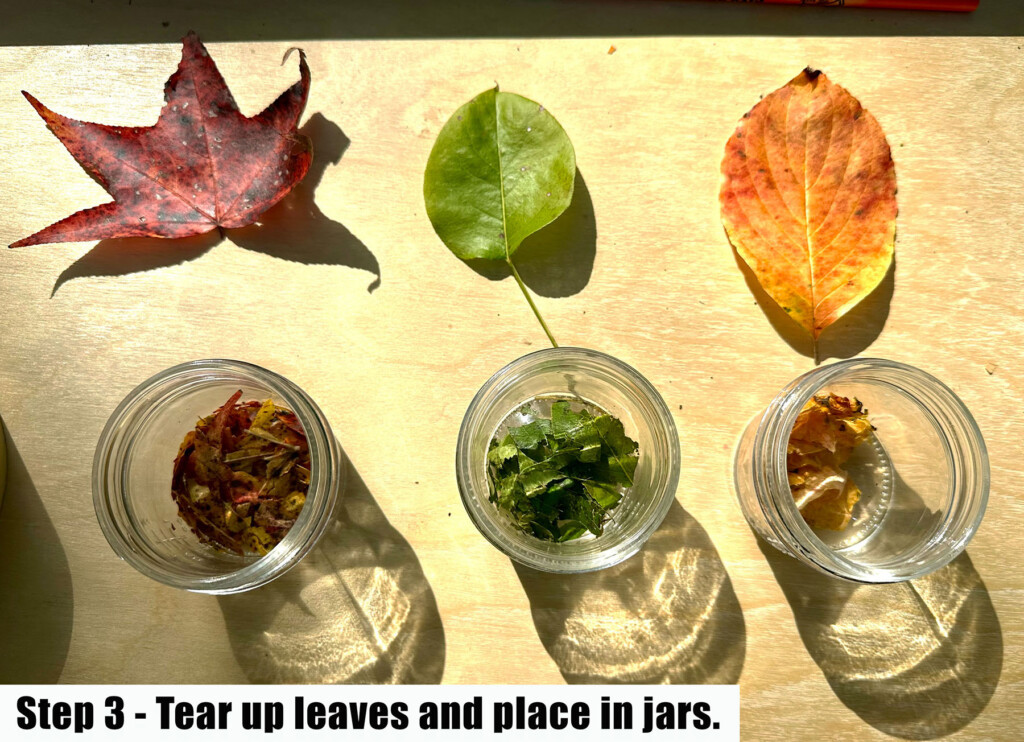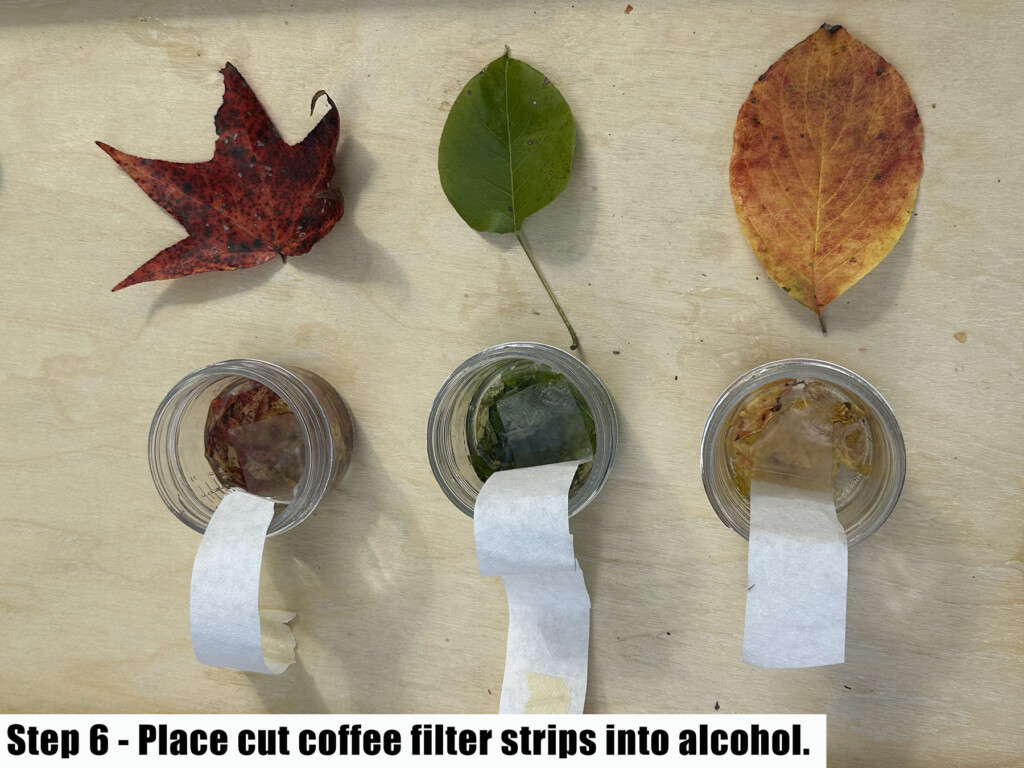Happy National STEM Day! We are so glad you dropped by. Did you know that forestry has been recognized by many, including the Homeland Security Department and the National Science Foundation, as a STEM field? Our forests and trees provide us with an abundant and easily accessible resource that supports learning in Science, Technology, Engineering, and Math. It doesn’t matter which subject area you’re focusing on; our trees can help with it all.
Let’s dive into STEM by experimenting with leaf chromatography. What is leaf chromatography? Simply put, chromatography is a process for separating components of a mixture. Leaf chromatography uses a process to separate the different pigments in leaves by using common household items. This process, known as paper chromatography, can help us discover the hidden pigments such as yellows, reds, purples, and more found in green leaves. It also works with leaves that have already changed color. That’s what makes it a fun experiment, whether it is spring, summer, or fall.
Ready? Let’s get started.
SUPPLY LIST:
- Glass or jar for each leaf type or color you collect (if you do this experiment in the summer you will want to sort by leaf type instead of color)

SUPPLIES - Spoon, rock, or mortar and pestle
- Isopropyl alcohol (rubbing alcohol)
- White coffee filters or paper towels cut into one-inch strips
- Tape
- Leaves of different colors (see tips below for choosing leaves)
- (optional) pencil or stick for each glass jar
Don’t Touch Me! Please be mindful when collecting leaves to avoid poison ivy and poison oak.
Learn more on how to identify poison ivy, poison oak, and similar plants here: https://extension.okstate.edu/fact-sheets/poison-ivy-poison-oak-and-similar-plant-identification.html.
TIPS:
- For best results select leaves from the tree or plant. If you feel the leaves are freshly fallen, you can try using those too.
- Be sure that the isopropyl alcohol is not out of date.
- Crush leaves well.
- If you don’t have coffee filters, you can try using paper towels or tissue paper. Be sure that you use white filters. Unbleached filters or paper towels will not work as well.
- If you want to speed up the process, you can place your glass jars into a larger container and add a small amount of boiling water to the container to warm the alcohol. Do not put the boiling water in the glass with the alcohol.
DOING THE ACTIVITY:
- Collect leaves from a few different trees. Leaves can be green or have already changed. It’s an experiment, so feel free to try as many different leaves as you would like.
- Sort leaves collected by leaf type or color if doing this experiment in the fall. Select one to two leaves from each type/color to use.
- Tear up each leaf. Place each leaf type/color in a different container.5
- Use the spoon, rock, or your mortar and pestle to mash the leaves. You want to break them up as much as possible to help bring out the pigments.
- Carefully pour rubbing alcohol into each glass until the leaves are just covered.
- Cut coffee filters or paper towel into one-inch strips if you have not done so. Place one end of the strip into the alcohol. The other end you can secure to a pencil or stick on top of your jar or if your strip is long enough let it hang over the side of the jar. You can secure the strip on the outside with a small piece of tape to keep it from falling out.
- Place somewhere that it can sit undisturbed for two to three hours.
- After two to three hours check back to see if any pigments from the leaves can be seen on the coffee filter strips. If you see no pigments, wait another two to three hours or remove the strips, cover the jars and come back the next day. Add new filter strips, wait 30-45 minutes and check back to see if you have better results.





What are these different pigments and what happens to leaves to make them change colors in the fall?
Check out this video to learn more about why.
You may notice that some trees stay green year-round like your pines, cedars, and hemlocks. These are known as evergreens. Trees that give us the vibrant colors of autumn such as our oaks, maples, hickories, red buds, and poplars are known as deciduous trees which means that they shed their leaves annually. During the spring and summer months, leaves manufacture the necessary energy for a tree’s growth. This process takes place in the leaf cells containing chlorophyll. Chlorophyll is a chemical necessary for the photosynthetic process in plants and is what gives leaves their green color. Trees require warmer temperatures and sunlight to produce chlorophyll. In autumn, the amount of chlorophyll produced begins to slowly decrease and what is left in the leaves begins to break down. As chlorophyll breaks down, the green in the leaves begins to disappear leaving behind carotenoid and anthocyanin pigments. Carotenoids are present in leaves year-round; however, anthocyanin appear as the result of a chemical reaction which is activated by the sun when sugar concentration levels in the leaves increase. Carotenoids absorb green and blue rays, and reflect yellow, orange and browns. What color do you think anthocyanin gives us? If you said reds, blues, or purples, you would be correct. Anthocyanin absorbs green and yellow rays, and reflect the reds, blues, and purples. Anthocyanin is usually produced in the fall as a response to bright light and excess sugar build up in leaf plant cells. Twigs gradually close off and once it is completely sealed, leaves are ready to fall. The fallen leaves complete the nutrient cycle for the tree. From producing energy required for a trees growth during the warmer months to now providing natural mulch materials and replacing nutrients in the soil as they decompose.
QUESTIONS TO ASK YOUNG SCIENTISTS:
- What differences did you notice in each of the different leaves?
- What happened when we placed the filter/paper towel into the liquid?
- Did you notice anything happening each time that you checked your experiment? What was happening?
- What is the green pigment that is found in leaves? Do you know what that pigment helps with?
- What would you do differently if you did this experiment again?
